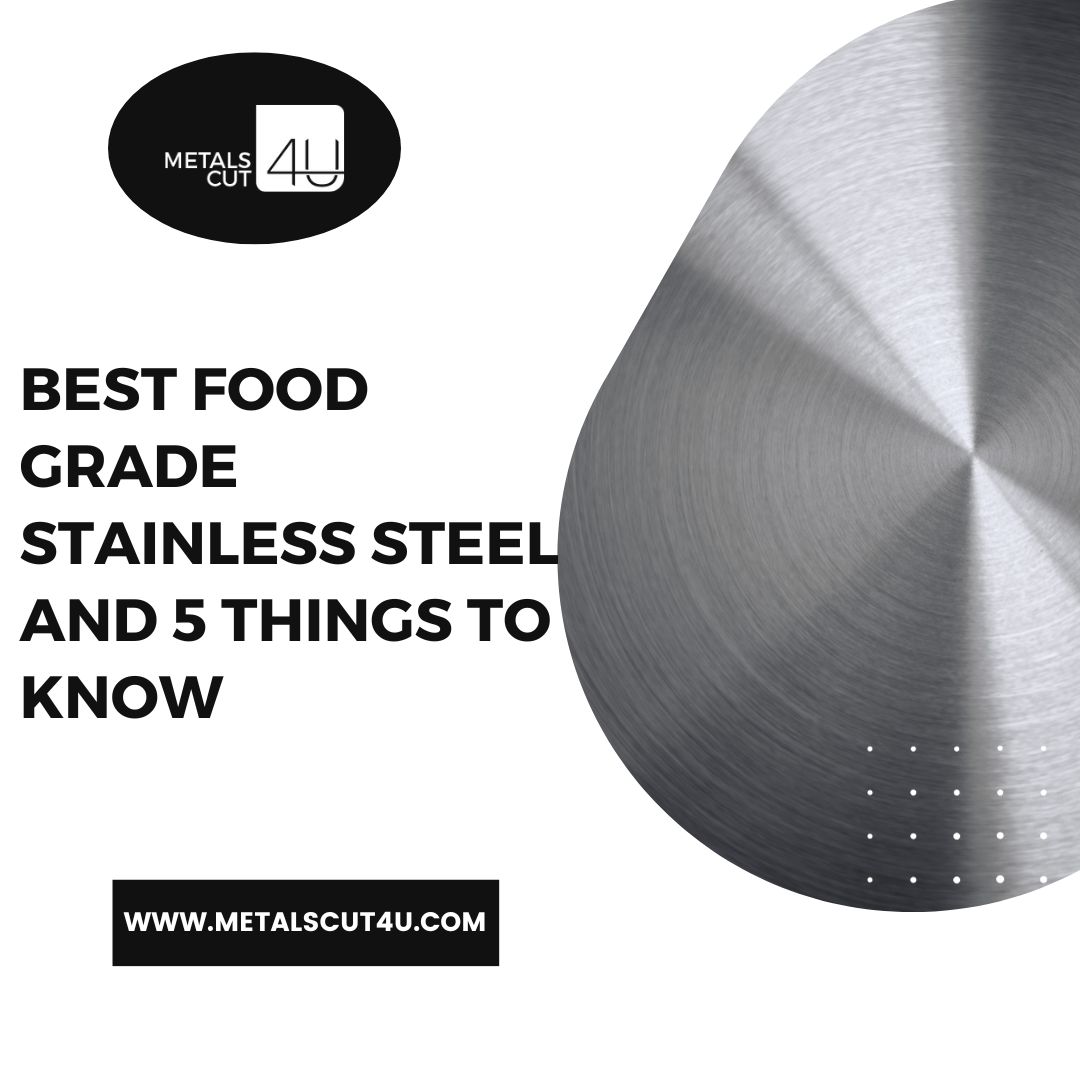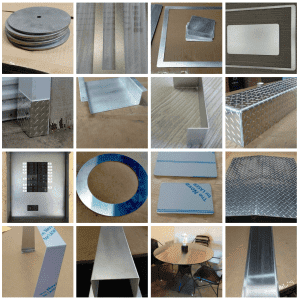Best Food Grade Stainless Steel And 5 Things To Know

The food sector has strict criteria that manufacturers must follow to maintain complete FDA compliance and avoid contamination. The obvious choice for any machinery or goods that will be used in the processing of food or beverages is stainless steel. However, some may be unaware that not all stainless steel is considered food-grade.
Stainless steel that makes it possible to manage food items following governmental safety standards while maintaining the highest levels of purity and quality is called "food grade."
Let’s take an example of salt, which is regularly introduced to a steel's surface during food processing, is a food substance that is extremely resistant to acids, alkalis, and chlorides. Food-grade stainless steel surfaces are made to be more durable, smoother, and resistant to these substances.
In this post, we will explore the best type of food-grade stainless steel to use for food processing.
What Is Food-Grade Stainless Steel?
Let’s understand what food-grade stainless steel is. In the food sector, stainless steel is subjected to heat, water, and harsh cleaning substances. Food-grade stainless steel holds up well, is free of rust and corrosion, and is easy to clean during those exposures. Additionally, the pitting resistance means it retains a surface that is simple to maintain and clean. Last but not least, the metal can withstand high temperatures because of its heat resistance.
Because of these factors, many food makers use stainless steel metal trays throughout the food-cooking process. Some people might not be aware, though, that not all stainless steel is the same. Hundreds of different types of stainless steel are available, each with a special set of characteristics.
The best stainless steel depends on the particular application or use. For instance, a processor specializing in tomato sauce will have very different performance requirements than a confectioner preparing chocolates.
Why Is It Used In The Food Industry?
Stainless steel refers to iron-based alloys that include at least 11% chromium. Other metals, particularly nickel, and other elements, like carbon, are included in the alloy. Stainless steel's unique and diverse constituent composition gives it the qualities that make it valuable in various sectors, including the food industry, especially those where the metal will be exposed to harsh environmental conditions.
If you need clarification on brushed stainless steel vs stainless steel, visit our website for a better understanding.
Different Types Of Food Grade Stainless Steel
1. Food Grade Stainless Steel 316
-
Food Grade Stainless Steel 316 is a high chromium and nickel austenitic stainless steel alloy. It has a continuous use temperature several times greater than most food manufacturing processes will ever require more than 800°C, or 1472°F, like many steel alloys.
-
The grade 316 alloy's exceptional resistance to acids, alkalis, and chlorides (such as salt) makes it the best food-grade stainless steel sheet material. Salt, frequently present in food goods, can cause severe pitting corrosion in other austenitic stainless steels, such as grade 304 SS.
-
For almost any culinary use, 316 stainless steel creates excellent food-grade containers.
2. Food Grade 430 Stainless Steel
-
Food-grade stainless steel 430 is an extremely comparable alloy to grade 316 stainless steel. It is cheaper for some food manufacturers since it has the same amount of chromium as 316 but much less nickel.
-
The fact that grade 430 stainless steel is a ferritic alloy, which means it is magnetic by default, is another significant distinction compared to grade 316 stainless steel. Ferritic alloys, such as 430 SS, are also extremely resistant to stress corrosion cracking (creating cracks that can cause rapid failure in corrosive situations).
-
Because of its high resistance to nitric and organic acids, 430 SS is frequently utilized for applications where prolonged contact with slightly acidic chemicals is a concern. Additionally, the alloy boasts resistance to oxidation and sulfur.
-
The low nickel concentration, however, makes this alloy less resistant to some diluted reducing acids than grade 316 stainless steel.
3. Stainless steel food grade 304
-
It has a higher chromium content than SS 316, which increases its resistance to acidic foods and liquids. Its uses are restricted to processing specific non-chloride foods because it doesn't function well in the presence of chlorides.
-
Vats, bowls, piping, machinery parts for the dairy industry, and breweries are a few examples of 304 stainless steel food-grade equipment.
Other varieties of stainless steel food grades with significant uses in the food sector include:
-
Martensitic stainless steel food grade 420 is used to create kitchen utensils, expert knives, spatulas, etc.
-
Austenitic stainless steel food grade 1.4539 treats salty foods that are slow to move, stagnant, and corrosive to solids.
-
SS 1.4462 Duplex stainless steel food grade is stronger than austenitic grades and strongly resistant to stress corrosion cracking in salt solutions at high temperatures.
Which Is The Best For Food-Safe Stainless Steel For Application?
In general, SS food grade 316 is frequently a superior option for producing containers made of food-quality stainless steel. In many applications, especially when working with salt and more potent acids like lemon or tomato juice, 316 SS is more chemically resistant.
For food manufacturers who want a moderately resistant, food-grade steel sheet for their manufacturing process, 430 is an excellent, less expensive solution.
It is important to note that electropolishing can improve the resistance characteristics of both alloys. This procedure not only strengthens the steel's protective oxide layer but also smooths out the alloy's surface, making it easier to clean and less likely for food to stick to the metal.
5 Best Things For Grade Stainless Steel
1. Rust-free Metal
The surface of stainless steel is smooth and rust-free. Stainless steel is resistant to numerous elements that iron alone could not survive because it combines iron and chromium. Many metals would be damaged by corrosion or prolonged exposure to water, but stainless steel is not one of them. You can freely soak stainless steel in water without worrying about rust.
2. Easy cleaning and maintaining
The ability of stainless steel to resist corrosion is highly beneficial for maintaining the cleanliness of surfaces used for food and beverages. The stainless steel's polish almost minimizes the possibility of bacterial development. It's simple to disinfect and clean.
3. Availability of various food-Grades
Not all stainless steel is the same. The most often used stainless steel grades for kitchen and culinary use are 304, 316, and 430. SS food-grade 304 is used for kitchen equipment and appliances. 316 is used for cutlery with a smoother finish and avoids corrosion.
4. Resistance to Corrosion
In addition to being durable and safe, stainless steel is also resistant to corrosion. SS food grade is resistant to absorbing colors, odors, or other substances. It is crucial when attempting a rapid sanitization of commercial cookware or applications. Also, It is frequently used in food, surgery, and other applications due to this repulsive quality.
5. Supremacy to Aluminum
When exploring alternatives to stainless steel, aluminum is frequently a popular consideration. Aluminum has certain drawbacks in the kitchen despite being a potentially less expensive option. Its quick heating and cooling make aluminum's low tensile strength ideal for baking trays. When using cutlery or culinary tools, there are better options than this. The temperature changes pose a safety risk. 304 and 316 stainless steel can be the best choice if you're looking for a stronger and safer food-grade metal.
Remember These Things While Utilizing Food-Grade Stainless Steel.
Never Clean Stainless Steel With A Plain Steel Brush.
-
Steel wire brushes are a common alternative for removing deeply embedded stains from metal surfaces. However, it would be best never to clean a stainless steel object with such brushes.
-
The stainless steel surface can become embedded with plain steel brush particles, risking the integrity of the shielding oxide layer. As a result, the "stainless" steel will eventually rust like regular steel.
-
Furthermore, you should avoid cleaning stainless and regular steel using the same tools. The stainless steel could pick up particles from the plain steel.
Extreme temperatures can have an impact on food-grade stainless steel.
-
Low temperatures have the potential to harm stainless steel shapes. Most stainless steels have melting points far higher than those frequently used in food-related processes.
-
When choosing food-grade stainless steel (and any prospective coatings), paying attention to temperature extremes in your manufacturing process is still crucial.
The steel's finish may impact how suitable it is for processing food.
-
Although stainless steel is renowned for its ability to resist corrosion, just because the surface appears smooth and bright doesn't guarantee that it is food-grade.
-
The steel's finish is easy to clean, disinfect, and free of surfaces, supporting bacterial development to achieve important sanitary criteria.
Conclusion
At MetalsCut4U, we provide top-notch personalized metal fabrication services using food-grade stainless steel to ensure that your projects adhere to the strictest quality and safety guidelines. Also, food-grade stainless steel is vital in many businesses, especially concerning food processing and storage. Count on us to provide the ideal solution based on your demands. Visit MetalsCut4U today to learn more about the versatility of food-grade stainless steel!
